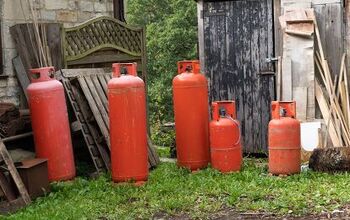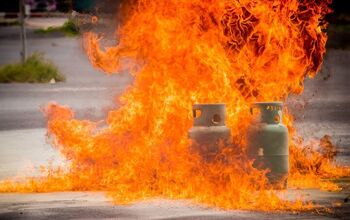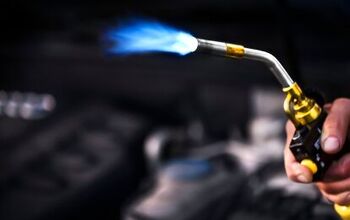Can A Gas Dryer Run On Propane? (Find Out Now!)
It is commonplace to find either electric dryers or gas dryers in US homes. Both of them have their benefits and drawbacks. Some prefer the efficiency and energy-saving qualities of a gas dryer, and some prefer the cheaper outright cost and safety of an electric dryer.
Let’s say you’ve already decided a gas dryer is the best option for you. Gas dryers are manufactured for natural gas. But you might be curious, can a gas dryer run on propane instead?
The answer is YES, most gas dryers can be converted to run on Liquid Propane (LP) by installing a conversion kit. This involves changing the gas regulator pressure and burner orifice. If your gas dryer doesn’t come with an LP conversion kit, you can purchase one at most home improvement stores. This installation is technical, but can be completed yourself.
Do You Need Gas Appliance Services?
Get free, zero-commitment quotes from pro contractors near you.

What is a Gas Dryer?
A gas dryer is a clothes dryer that is designed to utilize natural gas as its source of energy. The gas is used to heat the clothes. Without gas, a gas dryer will run when plugged into electricity, but will not be able to produce heat.
Gas dryers have many benefits over electric dryers. While they are more expensive to purchase, their energy efficiency over time saves money. It takes less money in gas usage to dry your clothes than money in electricity usage, because it warms your clothes faster. It also requires only 110 volts of electricity to run, whereas electric dryers require 220 volts.
Gas dryers can be fueled by either natural gas or propane. Most gas dryers are designed for natural gas use, but can be converted for propane with the right equipment. The downside of gas dryers is they run a higher risk of fires, explosions, and gas leaks than electric ones.
Benefits of Converting Natural Gas Dryer to Propane
Are you interested in using propane as the source of heat for your dryer? There are a few benefits to using propane instead of natural gas.
- Efficiency. The same amount of propane produces twice as much heat as natural gas. It takes less volume of propane to complete a clothes dry cycle than natural gas.
- More available. Natural gas is not always accessible, depending on where you live. On the other hand, propane can be purchased almost anywhere.
- More environmentally friendly. Natural gas extraction is a lot more destructive to the environment than how propane is sourced. Propane is also a less toxic greenhouse gas.
If you want to take the leap and convert your gas dryer to propane, you will need to purchase an LP dryer conversion kit. By following the directions closely, your dryer will be up and running with propane in no time. It is also possible to convert a gas dryer to an electric, but that’s another story.
How to Convert Gas Dryer to Propane
Before you make any changes, you should read the owner’s manual for your dryer. The manual will indicate if it’s possible or not to use propane for your particular model. But most gas dryer models should be convertible to propane.
Once you verify that this is possible, you will need to purchase a dryer LP conversion kit. You can buy a dryer conversion kit at most home improvement stores, or on Amazon. Kits range in price, from as low as $15 up to $55, depending on your dryer model.
Your conversion kit will come with the necessary components and detailed installation instructions. If you’re not comfortable with appliances, it’s better to be safe than sorry. Defer to a qualified servicer to complete the installation for you. Improperly converting a gas dryer comes with safety hazards, increasing the risk of gas leaks or explosions.
Step One: Shut off the Gas and Electricity
It is incredibly important before working with flammable materials like gas to shut off the gas valve and unplug the dryer. You don’t want to risk electrocution, or any gas leaks or fires from the burner.
Step Two: Remove the Front Panel to Access Gas Control Valve
The goal with this conversion is to replace the burner orifice. A natural gas orifice is too big for propane, and thus would let in too much propane. This can cause the flame to grow too large and potentially start a fire.
To find the burner, you’ll need to unscrew and remove the front panel. Once you find the burner, remove the access door. This will reveal the gas control valve. Make sure to turn off the gas. Then unplug the quick connect wire on top of the gas control valve.
Step Three: Remove the Burner
Now the quick connect wire is unplugged from the control valve. Loosen the hex nut and remove it from the control valve. Then unscrew the metal plate that is holding down the control.
You should remove the burner now, but only enough that the wires still remain attached to the flame sensor. Then find the quick disconnect wire, and unplug. Once you unplug these, fully remove the burner. This will reveal the brass or bronze natural gas orifice.
Step Four: Replace the Orifice with an LP Orifice
Now you can unscrew the natural gas orifice and remove it. Using the parts provided in your conversion kit, install the LP orifice where the old one was.
Once this is complete, you will put all parts of the dryer back in place by reversing these steps. Light the burner and start it up! You shouldn’t smell any sulfur or rotten eggs. If you do, immediately shut off the gas and hire a qualified professional to check your kit installation.
Do You Need Gas Appliance Services?
Get free, zero-commitment quotes from pro contractors near you.

Related Questions
What are the best gas dryers?Some of the top brands on the market provide reliable, quality gas dryers. Samsung has a couple of different models, one of which includes a steam and sanitize feature. GE also offers a highly rated gas dryer. Additional quality brands include Whirlpool and Kenmore.
Why is the gas dryer not heating?
Your gas dryer might not be heating for a number of reasons. There might be a blockage or restricted air flow in the vents. You might also have a blown thermal fuse. There may also be defective gas valve coils.
More by Jessica Vaillancourt























![Cost To Drill A Well [Pricing Per Foot & Cost By State]](https://cdn-fastly.upgradedhome.com/media/2023/07/31/9074980/cost-to-drill-a-well-pricing-per-foot-cost-by-state.jpg?size=350x220)



